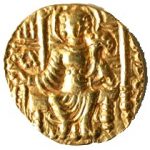Coins of Kushana Dynasty
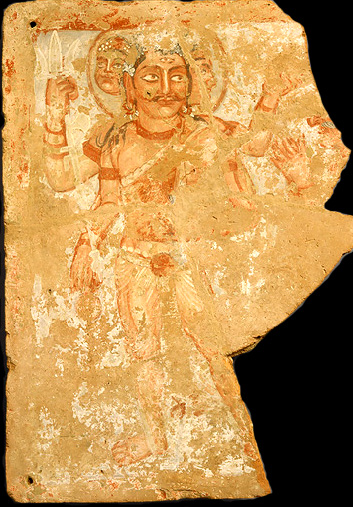
The name Kushan is derived from the term Guishang, used in Chinese historical writings to describe one branch of the nomadic people, called Yuezhi or Yuechi. These nomads, who were of Indo-European stock, roamed the northwestern China but during 176-160 BC, they were driven west by another group, the Xiongnu. The political disturbance in central Asia (and possibly the availability of better and prosperous land and other resources) drove these nomads out into Bactria (modern northwest Afghanistan, Uzbekistan and Tajikistan). In 165 BC, few tribes settled in Oxus river (Amu Darya) valley and established independent existence.
Kujula Kadphises (30-80 AD) established the Kushan dynasty in 78 AD by taking advantage of disunion in existing dynasty of Pahalava (Parthian) and Scytho-Parthians, and gradually wrested control of southern prosperous region, which is the northwest part of ancient India, traditionally known as Gandhara (the region between Kabul and Indus rivers, now in Pakistan). It was his grandson Vima Kadphises (Yen-kao-chen in Chinese record), who made Kushan a paramount power of northern India. His reign saw emergence of Kushan empire when he conquered north-western India (modern Punjab, now divided in Pakistan and India). Kushan empire covered north west of India (includes Pakistan and modern Afghanistan) and northern India. Ample evidences of trade with China, central Asia, Egypt and Rome are available, which made their economy very strong and kingdom wealthy and prosperous. Kushan rulers adopted the local culture and contemporary religious belief, the `early’ form of Hinduism, rather rapidly. He took opportunity to proclaim himself Mahishwara, another name for Lord Shiva, on his coins. Lord Shiva is a prominent (and possibly the earliest) Hindu god, often shown in human form as one or three headed (actually considered to be four or even five headed, with three visible heads) with or without his vehicle, the bull, Nandi. He carries the trident and has third eye on his forehead, which is clear in the Kushan votive panel, shown on left.
VIMA KADAPHISES (110-128 AD)
Kushan kings introduced gold and copper coins, a large number of them have survived today and remains possibly the most informative evidence of their reign, extent of empire, their personal beliefs and even their looks!
It was the Kushan emperor, Vima Kadaphises who introduced the FIRST gold coins of India. The Distater (two-stater) or the Double Dinar (two Dinars) showing king sitting on throne can be safely considered as the first gold coin of Indian subcontinent. On Obverse one can see the bearded king wearing diadem, seated on high couch (throne) with feet resting on a foot-stool, holding in right hand a twig or branch of spice plant, a club in foreground to his right. His feet is resting on foot-stool. The Greek (not Bactrian) legend Basileus Ooema Kadaphises starting at `I’ position. The Kushan symbol is in upper right field. On Reverse, it is Lord Shiva (often shown Naked with erect phallus) holding trident in right hand, standing with Nandi, the bull. The legends are in Sanskrit, written in Kharoshti legends `Maharajasa rajadirajasa sarvaloga ishwarasa Mahiishwarasa Vima Kadaphisasa Tratara‘ starting at XII position. The legend on reverse can be translated as: Emperor, the King of Kings, follower (?) of the great god (god of all) Shiva, Vima Kadaphisa, the savior. The concept of calling kings as `savior’ was the idea almost certainly borrowed from early Greek rulers, portraying themselves as caretakers of subject. The Nandipada symbol is on left.
Vima mostly used one deity, Lord Shiva (Oesho in Bactrian language) standing (with trident) with (or without) his bull Nandi, on reverse of his coins. This was one of THE BEST numismatic icon ever been created in the history of India. The concept of showing King on obverse and god/goddess from Hindu (sometime from Buddhist, Greek and Zoroastraian) pantheon became so popular that it was used for more than 6 centuries in India on practically all the gold coins. Later, in modified form, it was used till 11th century AD.


Vima Kadphises
Gold Distater (or Double Dinar), Weight: 15.75 gms, Possibly the FIRST GOLD COIN of India
Obverse: Bearded, diademed King, seated on high couch (throne), holding spice plant. The Greek legend `Basileus Ooema Kadaphises‘ starting at `I’ position. The Kushan symbol is in upper right field.
Reverse: Naked Shiva standing, holding trident in right hand, standing with Nandi, the bull. The Kharoshti legends Maharajasa rajadirajasa sarvaloga ishwarasa Mahiishwarasa Vima Kadaphisasa Tratara
Reference: GK#11
Extremely Rare
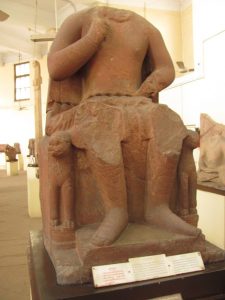
The statue unearthed near Mathura, now housed in Mathura museum, shows Kushan inscription indicative of Vima’s name (Maharaja rajatiraja devaputra Kushanaputra (Shahi Vamataksha) masya Vakanapatina Huma (devakulu) karita Arama pushkarini udapana (cha) sa-da (kothako). Here Vima is shown sitting on throne (shown on left), which seem to be replicated on the double dinar, shown above.
Shown below are two more double dinars of Vima, which are preserved in practically mint condition. Each of these coins, truly masterpieces of Kushan dynasty, shows King emerging from clouds, the divine quality that kings wanted to show to his subject. The obverse legend is in Greek (not Bactrian).
Undoubtedly all the Kushana emperors used their coinage for the propaganda of their own superiority and the possession of superhuman abilities! The concept of showing king/ruler on the coins was non-existent in India and all the previous dynasties including the great Mauryas, minted coins showing only the symbols (punchmarked coins). It was the Kushan rulers who popularized this idea, which even though borrowed from Indo-Greek coins, they made enough modification to create their own unique version. Indeed, the good enough that Kushan style remained in use for another 1000 years! Kushan coinage were copied not only by later Indian dynasties like Guptas, but also by the neighboring kings like Sassanians of Persia/Iran.
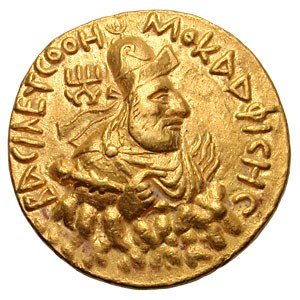
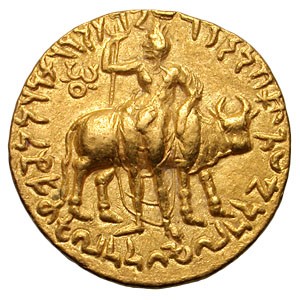
Vima Kadphises Distater, Bilingual (Distater or Double Dinara/King on cloud, right), Weight 16.01 gms, Gold Obverse: Bust of king right on cloud, holding mace in right hand, far shoulder flaming, tamgha in left field. The Greek legend `Basileus Ooema Kadaphises’ starting at `I’ position. Reverse: Shiva standing facing, head left, holding trident in right hand, bull standing right behind him, nandipada in left field. The Kharoshti legends `Maharajasa rajadirajasa sarvalogaishwarasa Mahiishwarasa Vima Kadaphisasa Tratara’ starting at XII position is around. Reference: Mint A, emission 3. Gobl 12 (same obverse die). For reverse die see Gobl 10,1Nearly mint stateExtremely Rare
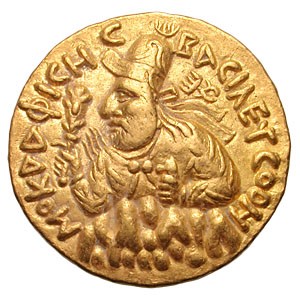
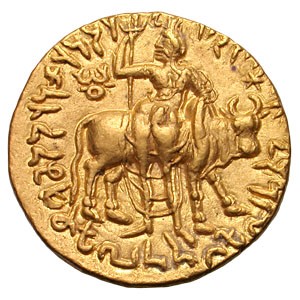
Vima Kadphises
Distater, Bilingial (Distater or Double Dinara/King on cloud, Left), Weight: 15.93 gm, Gold Obverse: Bust of king left on cloud, holding raised mace in right hand and sword hilt in left, far shoulder flaming, tamgha in right field. The Greek legend `Basileus Ooema Kadaphises’ starting at `I’ position. Reverse: Shiva sanding facing, head left, holding trident in right hand, bull standing right behind him, nandipada in left field. The Kharoshti legends `Maharajasa rajadirajasa sarvalogaishwarasa Mahiishwarasa Vima Kadaphisasa Tratara’ starting at XII position is around. Nandipada symbol is on left.Reference: Mint A, emission 3. Gobl 13.Good extremely fineExtremely Rare
Unfortunately, very few evidences of Kushan rule survived today. Indeed, Kushan coins are perhaps the best evidence we may have of this illustrious dynasty. Kushan coins tell a great deal about the images of the kings as they wished to be seen by their subject. The portraits on Kushan gold/copper coins of Vima Kadphises are realistic and amazingly individualistic, often showing him full-bearded, big-nosed, fierce looking warrior ruler, perhaps with slightly deformed skull, wearing high helmet, tunic, overcoat and felt boots. This is also seen on the very few surviving sculptures of these mighty rulers, often missing heads (Vima and Kanishkas sculptures are shown here, uncovered near city of Mathura and now housed in museum there).
Vima issued gold coins in three denomination, Double Stater or Distater/Double Dinar (~16 gms), Stater or Dinar (~8 gms) and Quarter Stater or Quarter Dinar (~2 gms). Double Dinars are shown above, while Dinars and quarter Dinars are shown below.
Kushan gold coins are sometimes called as `Dinars’, a word derived from Roman silver coins, Denarius. It is to be noted that Kushan rulers were contemporary of Roman emperors; Vima’s rule overlapped two of the Roman emperors, Trajan and Hadrian. And the Roam gold coins, called Aureus, did reach Kushan realms due to brisk trade along the silk road, which passed through Kushan empire and was one of the major source of gold. Kushan rulers minted their gold coins with the same weight standard as of Aureus, which was determined to be ~8 gms of gold, first by Julius Caesar and later continued by Augustus and his successors. By that definition, the correct term for Kushan coins would be Staters rather than Dinar.

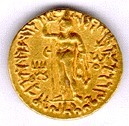
Vima Kadphises
110-128 AD
Stater, Bilingual (LORD SHIVA/left TYPE)
Weight: 7.88 gm, Gold
Obverse: Bust of King, emerging of clouds, looking left
Reverse: Naked Shiva standing, holding trident and lion skin, Kharoshti legends
Reference: Gobl#19
Good Very Fine
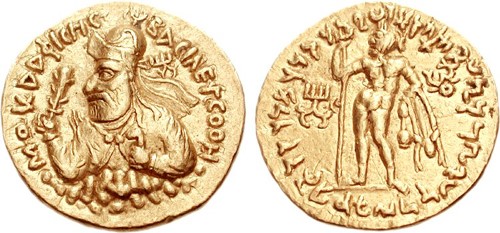
In addition, Vima also issued copper coinage, in three denominations, Tetradrachm (~17 gms) Didrachm (~8.5 gms) and Drachm (~4.2 gms). A fine example of his Tetradrachm is shown below, where Vima is seen sacrificing at an altar. On reverse, Shiva and Nandi are seen. The obverse of this coin had legends written in cursive Greek (Bactrian), while reverse showed legends in Sanskrit, written in ancient Indian script, Kharoshti.

Vima Kadphises
Quarter Stater, Bilingual (King looking through window)Weight: 1.95 gm, Gold
Obverse: Bust of King looking through window, clear legend in Bactrian BACILEV(C OOHMO) KADFICHC
Reverse: Trident, phallus and drum, Kushan symbol and Nanadipada in the left and right field respectively, Kharoshti legends
Reference: Gobl# 9.9
Almost Extremely Fine, broad specimen with clear legend
Undoubtedly, Vima’s coins were influenced by his predecessors Indo-Greeks, who were overthrown by Kushan. Later Indo-Greeks had issued bilingual coins (perhaps first time in the Indian history) and that explains bilingual nature of Vima’s coin. Although, interestingly the most prominent deity on Vima’s coin was not from Greek pantheon, but it was Lord Shiva, an earliest god of Hindu mythology. This fact makes Vima’s and other Kushan emperor’s coins very special in Indian numismatics.
Vima was founder of Kushan monetary system, based on 8 gms of gold staters and ~16 gms of copper. His wight standards were later used by Gupta emperors and thus remained effective for almost 4 centuries in India! All early Kushan rulers minted excellent gold and copper coins, displaying various deities on revere. The most prominent deity of early Kushans (till Vasudeva I) was Lord Shiva with or without his official vehicle, Nandi. Later Kushans, the rulers who occupied Kushan throne after Vasudeva I, had Laxmi or Lakshmi, the goddess of fortune and wealth on reverse of their gold coins. Lakshmi, as goddess Ardoxo, was shown on few coins of Kanishka and Huvishaka, but later Kushans altogether gave up the most common icon of Kushan dynasty, the Shiva and Nandi and practically minted all their gold coinage depicting Lakshmi.
This switching of deity on Kushan coinage is very interesting facet of the transition period of Kushan history. Gupta emperor, Samudragupta was the first to take serious note of coinage of his predecessors. No doubt, Samudragupta carefully studied the available Kushan coinage. He minted first gold coins of Gupta dynasty which were almost copied from later Kushan. The Kushan gold weight standard of ~8 gms is very close to Greek and early first century Roman coinage. The trade with Rome had brought large quantity of Roman gold coins in Kushan empire, which were melted for coin production in Kushan mints. Northern India never had much of gold producing mines, thus indicating the Roman gold which poured in India in ample due to the trade, was the major source of Kushan gold. Silver coins were rarely minted, which could be because of the widespread availability and/or debasement in earlier punchmarked coins.
KANISHKA (128-154 AD)
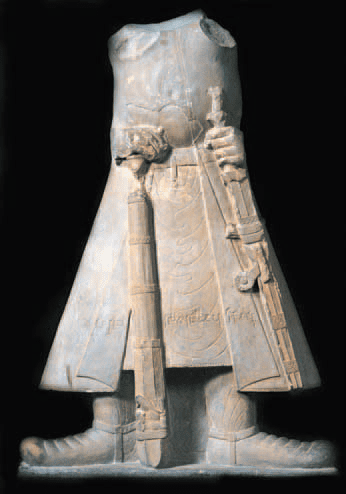
Vima’s able son Kanishka followed and took control of this dynasty in 128 AD. Kanishka is the legendary ruler of ancient India and according to most historians, the greatest ruler of Kushan dynasty. He was the first ruler of the ancient world ever to show shoulder flames and nimbus around the royal head on his coins (giving himself the divine status). He and his descendants called themselves `Devputra‘, which means son of god, who ruled Aryavarta, the India.
Kanishka’s rock inscription has been unearthed in 1993 at Rabatak near Surkh Kotal in Afghanistan. It describes him as a ruler, his genealogy and the extent of his empire. Rabatak inscription is written in Bactrian language (the Aryan language, as claimed by Kanishka, to distinguish it from Ionian or Greek language, possibly used in official matters in that period due to influence of the earlier Indo-Greek rulers of Bactria and Gandhara), written in Greek script. It is one of the major finding of Kushan realm, which provided accurate date of his reign and also gives a list of the major cities, which were controlled by Kanishka. Four such mentioned cities are Saketa, Kausambi, Pataliputra, and Champa . This provides clear evidence that his empire consisted Bactria (modern Afghanistan), part of central Asia (Tajikistan), north-western India (modern Pakistan) and Northern India till Pataliputra or Patana (modern Bihar state), modern Punjab, Jammu and Kashmir, Delhi, Uttar Pradesh and Bihar states). This inscription also indicates the overcoming of Yavana (Ionian or Greek) speech that existed that time in his kingdom, replacing with Aryan speech! He also proclaimed to have his rule consecrated by various divinities, such as Nana, Omma (Uma or Parvati, concert of Lord Shiva), Ahura Mazda, Komaro (Kumara or Skanda, son of Lord Shiva), Maaseno (Mahasena, another name for Skanda/Kumara), Bizago (Visakha, another form of Skanda/Kumara) and Miro (Mihira).
Shown on left is a sculpture of Kanishka, housed in Mathura museum. Similar to his father’s statue in the same museum, this is also headless, but bears his name. Significantly, the sculpture possesses the striking resemblance to his portraits on the coins, shown below.
Kushan empire was at it’s peak in terms of area during his and his son’s reign. Kalhan, a poet and historian of Kashmir, who wrote a famous chronicle of Kings of Kashmir, `Rajatarangini‘, a crucial historic document, testified that Kashmir was part of his empire. He also built a city called Kushka in Kashmir, which was named after him.

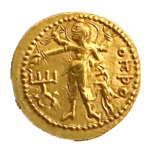
Kanishka I (the great)128-154 AD Stater or Dinar , Weight: 7.9 gm, GoldObverse: King looking left, Sacrificing at Altar with his right hand, left hand holding bow. Legends are in Bactrian. Flames emerging from shoulder.Reverse: Four armed Lord Shiva (OHPO) standing to left, symbol in left field. Shiva holds the Damru (Drum), Kamandalu (Vase) and Ankusha (elephant goad) in his right hands, the trident in his upper left hand. The lower left hand, he holds the Mriga, an Indian antelope by horns.Extremely Fine
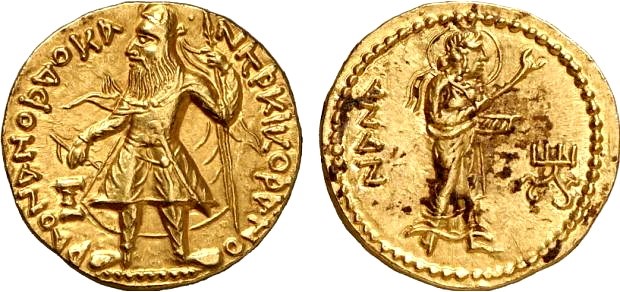
Kanishka I (the great)
Stater or Dinar , Weight: 7.9 gm, Gold
Obverse: King looking left, Sacrificing at Altar with his right hand, left hand holding bow. Legends are in Bactrian. Flames emerging from shoulder.
Reverse: Godess Nana (NANA).
Extremely Fine
Apart from being a successful warrior, Kanishaka was certainly a man of great taste and superior knowledge. He patronized contemporary intellectuals including sage, Shakya-muni, who had introduced him to Buddhism. Kanishka summoned a great council of contemporary scholars and philosophers to examine the Buddhist scriptures and prepare commentaries on them. A celebrated philosopher, poet and dramatist Ashvaghosha, who wrote Buddha Charita, was in his court. He built many monuments, the most celebrated of all is the great Chaitya/Stupa, known as Shah-ji-ki-dheri stupa, at his capital Purushpur (Peshawar, which is located near the capital of modern Pakistan). This massive Stupa has been admired by many travelers down to late period. Chinese travellers Fa Hsien and Hsuan Tsang wrote detail description of Kanishka’s temple building activity in Taxila and Gandhara (modern Pakistan). The casket/reliquary excavated from Kanishka’s great stupa is shown on right.The lid of the casket shows the Buddha sitting on lotus pedestal, and worshiped by Brahma and Indra. It contained three bone fragments of the Buddha, which were sent to Myanmar/Burma by the British archaeologists, following the excavation.
Kanishka minted coinage in two metals, gold and copper. Gold coins were minted in two denominations; Dinar (or stater) and quarter Dinars. Quarter Dinars are rare coins and and are considered as one of the finest example of miniature art. Two such rarities are shown below:
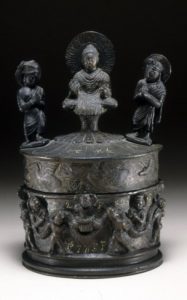
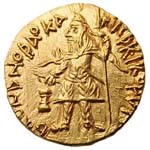
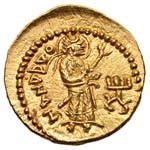
Kanishka I (the great)
Quarter Stater/Dinar (Nanashao) Weight: 1.99 gm, Gold
Obverse: King standing left, right shoulder flaming, cloak flying, sacrificing over altar and holding goad in right hand and spear in left. Legends are in Bactrian.
Reverse: Nanashao, nimbate, standing right, holding scepter in right hand and box in left, tamgha in right field.
Reference: Gobl#50 Mint state
Extremely Rare (only one in Gobl)

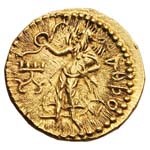
Kanishka I (the great)
Quarter Stater/Dinar (Athsho) Weight: 2.01 gm, Gold
Obverse: King standing left, right shoulder flaming, cloak flying, sacrificing over altar and holding goad in right hand and spear in left. Legends are in Bactrian.
Reverse: Athsho, god of fire, standing left, holding wreath in extended right hand, tamgha below in left field.
Reference: Gobl#47
Mint state
Extremely Rare (only one in Gobl)
HUVISHKA (154-192 AD)
Huvishka succeeded Kanishka I. The record of his reign has been unearthed at Wardak, near Kabul. Huvishka built many magnificent monuments at Mathura. He was founder of a city Hushka in Kashmir named after him (described by Kalhan in his famous book, Rajatarangini). Kushana empire was at its zenith during Kanishka’s and Huvishka’s reign. Huvishka took many titles including `Devaputra‘ (son of god) and perhaps was a patron of Mathura school of art. Dozens of breathtaking examples of this school of art can still be seen at Mathura museum.
Shown below is one outstanding example of Huvishka’s gold stater/Dinar, obverse of which shows him emerging from clouds, emphasizing his divine status (just like Vima and Kanishka). He is wearing rounded helmet decorated with antlers and crest ornament, jeweled yoke and loose fitting tunic. He holds an ornamental mace in his left hand and Ankusha (elephant goad or royal scepter) in right. Flames emerge from right shoulder. King is sporting Galamucha (sideburn). The Bactrian legend reads, ‘Shaonano Shao Ooeshki Koshano’(King of kings, Huvishka Kushan). On reverse is the Four armed Lord Shiva (OHPO in bactrian) standing, with Nandipada symbol in left field. Shiva holds the Damru (Drum), Kamandalu (Vase) in his right hands, and the trident in his upper left hand. The lower left hand, he holds the Mriga (his hunt), an Indian antelope, by horns.
Very likely, Huvishka was a sophisticated ruler, his cosmopolitan outlook is amply evident in his coinage. His early coins portray him as a warrior, sporting a beard and brandishing weapon (as shown below). But the transition is seen; his later coins show him a handsome king with a imperial crown and bejeweled tunic, having elephant goad/mace in his hand. This transition from a nomadic warrior (below) to a King accustomed to court life of opulence (a specimen of this type shown on right), represents the only such example in Indian numismatic history.
Huvishka minted coins with most variety, suggesting that his was the peaceful and prosperous reign. Although he has been patron of Hinayana Buddhism (record preserved in Mathura museum on pedestal of Bodhisattava sculpture), surprisingly, the coins showing Buddha were not minted by Huvishka.
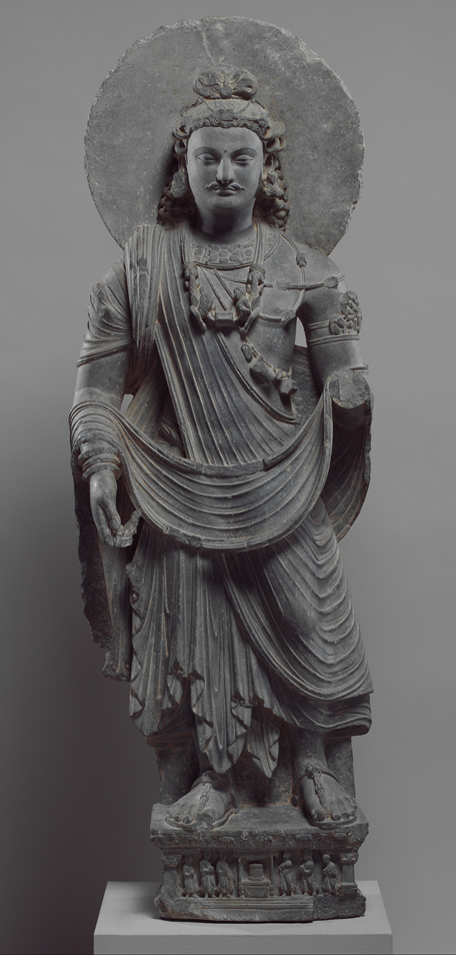
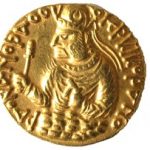
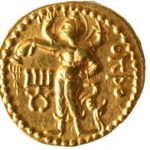
Huvishka
Dinar/Stater, Weight: 8.00 gm, Gold
Obverse: Half length profile Bust of King to left, emerging from clouds, wearing rounded helmet decorated with antlers and crest ornament, jeweled yoke and loose fitting tunic. He holds an ornamental mace in his left hand and Ankusha (elephant goad or royal sceptre) in right. Flames emerge from right shoulder. King is sporting Galamucha (sideburn). The Bactrian legend `Shaonano Shao Ooeshki Koshano’ starting at VII position.
Reverse: Four armed Lord Shiva (OHPO) standing to left, symbol in left field. Shiva holds the Damru (Drum), Kamandalu (Vase) and Ankusha (elephant goad) in his right hands, the trident in his upper left hand. The lower left hand, he holds the Mriga, an Indian antelope by horns.
Reference: Gobl#155.1, Virtually Uncirculated
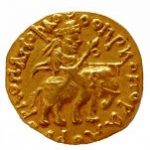
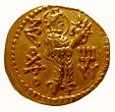
Huvishka
154-192 AD Stater/Dinar (Elephant Rider), Weight: 7.83 gm , GoldObverse: Huvishka riding elephant right The Bactrian legend `Shaonano Shao Ooeshki Koshano’ the King of Kings, Huvishka Reverse: “Ardoksho”, nimbate goddess standing right, holding cornucopiae, tamgha in right fieldReference: Gobl#305AVery FineExtremely Rare (only one in Gobl)
Huvishka minted many different types of Gold and copper coins and used deities from all the three ancient religions, Greek, Zorostrian and Hinduism. Vima’s coinage have deities from only Hindu pantheon, mostly Lord Shiva. Similarly, the Kanishka’s majority of coinage too have Shiva on his coins, but he introduced deities from Buddhist and Greek pantheon. But, unlike his predecessors (and successors), Huvishka has used the large number of deities from Zorostrian and Greek pantheon, clearly suggesting Bactria was still an important region of his empire. Significantly, Kushan rulers showed a syncretism, an amalgamation of different cultures and religions, which wasn’t seen prior or after them. Many contemporary deities of Indo-Iranian pantheon were seen in Kanishka’s coins (none of Vima’s coins), however, Huvishka’s coins had the most variety. Many of these deities were later became associated (and assimilated) with Hindu pantheon, one of the best example being Ardoxsho later identified as Laxmi or Lakshmi.
Shown below is an extremely rare coin of Huvishka, where he is show riding elephant on obverse and the three headed Shiva on reverse.
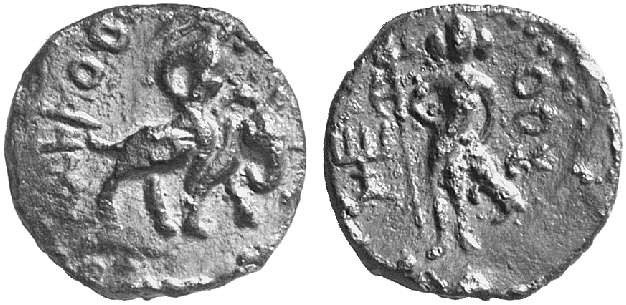
Huvishka
Copper Unit, Weight: 9.72 gm
Obverse: King riding elephant to right. He holds an Ankusha (elephant goad or royal sceptre) in his hand. The Bactrian legend `Shaonano Shao Ooeshki Koshano’ starting at VII position.
Reverse: Three headed, two armed Lord Shiva (OHPO) standing facing, trident and symbol in left field. Shiva holds in the lower left hand, the Mriga, an Indian antelope by horns.
Reference: Not in Gobl, Unpublished Very Fine
Extremely Rare
Some of the most interesting numismatic specimen with considerable historical importance are minted by Huvishka. One such coin (which is rare and highly desirable) of Huvishka shows a pair of deities, Skanda-Kumara and Vishakha (shown below). Skanda, also known by Kumara, Kumarswamy or Kartikeya (also known in modern south India as Murugan or Subrahmanya), is son of Lord Shiva. He is considered to be god of war and general of God’s army and hence is also known by another name, Mahasena. Vishakha is another son of Shiva and both Skanda and Vishakha were later merged.
Shown below is the coin of Mahasena (it also means, a great soldier), another name of Skanda-Kumara. This is perhaps the earliest known depiction in existence of this very popular god, especially in modern south India. On Obverse, half length profile Bust of King to left, emerging from clouds, wearing rounded helmet decorated with antlers and crest ornament, jeweled yoke and loose fitting tunic. He holds an ornamental mace in his left hand and Ankusha (elephant goad or royal sceptre) in right. King is sporting Galamucha (sideburn). This is an earlier type of portrait on coin. The Bactrian legend Shaonano Shao Ooeshki Koshano starting at VII position. On Reverse, nimbate figure of Mahasena (MAACHNO in Bactrian) an avatar of Kartikeyan, standing, holds a eagle-topped staff in his left hand and his left hand is resting on his hip. He has a sword, suspended from waist.
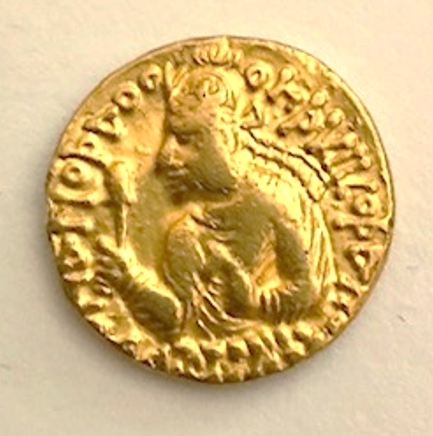
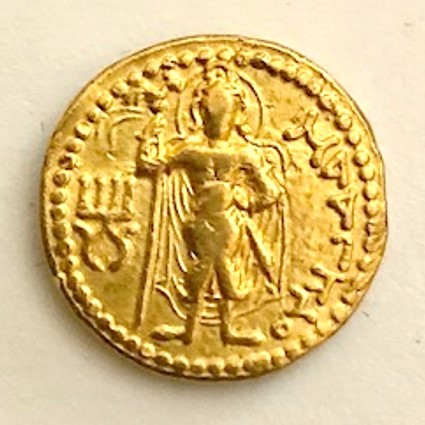
Huvishka
Stater/Dinar, Weight: 7.83 gm, GoldObverse: Half length profile Bust of King to left, emerging from clouds, wearing rounded helmet decorated with antlers and crest ornament, jeweled yoke and loose fitting tunic. Ornamental mace in his left hand and Ankusha (elephant goad or royal sceptre) in right. King is sporting Galamucha (sideburn). The Bactrian legend Shaonano Shao Ooeshki Koshano starting at VII position. Reverse: The nimbate figure of Mahasena (MAACHNO, MAASENO in Bactrian) is standing, facing. He is holding an eagle-topped ribboned staff in his right hand and his left hand is resting on his hip. He has sword suspended from the waist.Reference: Gobl#298.2 Extremely Rare
Another interesting rarity minted by Huvishka shows another form of Kartikeya or Mahasena, known as Skanda-Kumara. Shown below is a magnificent example of this gold coin where obverse shows similar profile as Mahasena coin, shown above. Coin shows on obverse the half length profile of King, emerging from clouds, holding an ornamental mace in his left hand and Ankusha in right. The Reverse shows two gods standing on a plinth decorated with a rinceau design, their hands turned towards each other. The god on left is Skanda-Kumara (CKANDO KOMARO in Bactrian) holds a globe-tipped staff in his left hand, while the figure on right is Vishakha (BIZAGO in Bacrtian), who holds trident. Both are diademed, wear the Dhoti and have swords suspended from their waists.
Huvishka also minted copper coins, an example of it is also shown above. Coin depicts King riding an elephant on obverse and reverse is 3-headed Shiva. The reverse with the moon goddess, Mao is another type. This copper coin was very popular and was extensively imitated by the various neighboring regions during and after his reign.


Huvishka
Stater/Dinar, Weight: 7.9 gm, Gold
Obverse: Half length profile Bust of King to left, emerging from clouds, wearing rounded helmet decorated with antlers and crest ornament, jeweled yoke and loose fitting tunic. He holds an ornamental mace in his left hand and Ankusha in right. Flames emerge from right shoulder. King is sporting Galamucha. The Bactrian legend reads Shaonano Shao Ooeshki Koshano, starting at VII position.
Reverse: Two male gods standing on a plinth decorated with a rinceau design their hands turned towards each other. The figure on left, Skanda-Kumara (CKANDO KOMARO) holds a globe-tipped staff in his left hand while the figure on the right Vishakha (BIZAGO), holds trident. Both are diademed, wear the Dhoti and have swords suspended from their waists.
Reference: Gobl#156.1 (same dies), Almost Extremely Fine, choice specimen
Extremely Rare
Huvishka also minted copper coins, an example of it is also shown above. Coin depicts King riding an elephant on obverse and reverse is 3-headed Shiva. This is an extremely rare coin. However, his common copper have the reverse with the moon goddess, Mao. This copper coin was very popular and was extensively imitated by the various neighboring regions during and after his reign.
VASUDEVA I (192-228 AD)
After Huvishka’s reign, Vasudeva I took control of this dynasty. Vasudeva I was the last great king of the Kushan dynasty when Kushana empire was at it’s height of splendor, prosperity and opulence. The largest number of Kushan coins that we uncover today seem to be minted during his reign. Most likely, he had his capital at Mathura (in northern India). He too was a patron of art and under his patronage Mathura school of art prospered. By the time of Vasudeva I, the Kushan dynasty had been totally assimilated in `Indian’ culture, as reflected in his and his successor’s coins. All the coins were minted showing either Lord Shiva (Oesho) or Laxmi (Ardoxsho). Never again deity of Greek or Zoroastrian/Iranian pantheon was used by Kushan rulers on their coinage. Indeed, the influence of Buddhism too seem waned, reflecting inclination of majority of population towards Hinduism.
Majority of Vasudeva’s coins were minted displaying Lord Shiva (as Oesho), often holding trident, Damru, a small Drum, and his bull, Nandi on reverse. An interesting aspect of his coinage include a series of gold coins minted showing four-armed, three headed Lord Shiva. The minute details of physical appearance displayed on these gold coins while portraying Lord Shiva (and his side heads) and his bull amply demonstrate the superb skills of die-engravers of Kushan period. Shown below is an excellent example of his coin, which is in mint condition. On obverse is the king shown wearing helmet and in complete regalia, sacrificing at a small altar. The legends are in Bactrian/Kharosthi, which are complete and very clear on this coin.

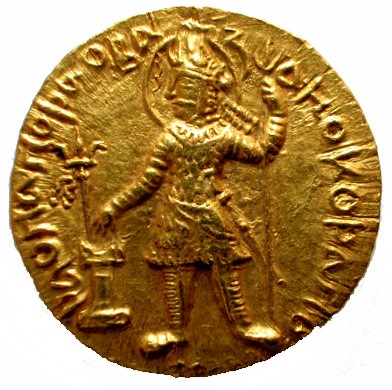
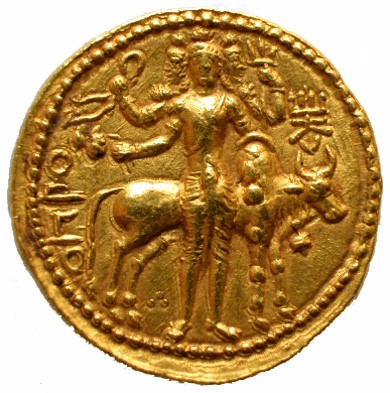
Vasudeva I
Stater/Dinar, Weight: 8.05 gm, Gold
Obverse: King Sacrificing at Altar with right hand, the left hand holding the trident. Another trident in the field. The Bactrian legend is around.
Reverse: Four-armed, Three-headed Shiva, side heads are human, standing with Nandi, looking right.
Reference: Gobl#506.3, Extremely Fine, choice specimen
Extremely Rare
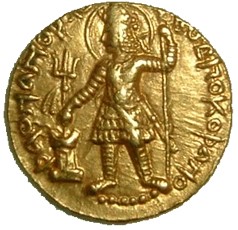
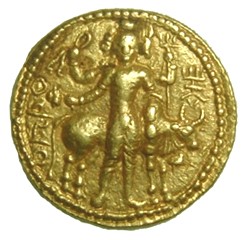
Vasudeva I192-228 ADStater/Dinar, Weight: 8 gm , GoldObverse: King Sacrificing at Altar with right hand, the left hand holding the trident. Reverse: Four-Armed, Three-headed Shiva, side heads are NOT human, human and Bull type, standing with NandiReference: Unpublished, NOT in Gobl, Similar to Gobl#500Almost Extremely FineExtremely Rare
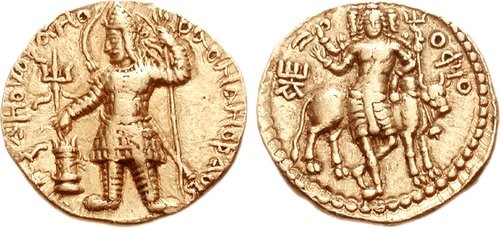
Vasudeva I (Possibly Vasudeva II)
Stater/Dinar, Weight: 7.88 gm , Gold
Obverse: Vasudeva, diademed and crowned, standing facing, head left, flames at shoulder, sacrificing over altar and holding trident; filleted trident to left
Reverse: Four-armed, Three-headed Shiva, side heads are human, standing with Nandi, facing. OhÞO, ithyphallic Siva standing facing, holding diadem in extended right hand, trident in left; behind, the bull Nandi standing right; tamgha to left.
Reference: Gobl#525 (O1/R1); Donum Burns 433. Mint I (A). 1st emission.Very Fine, choice specimen
Extremely Rare
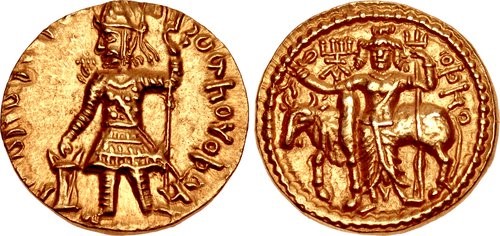
Vasudeva I (Possibly Vasudeva II)
Stater/Dinar, Weight: 7.88 gm , Gold
Obverse: Vasudeva, diademed and crowned, standing facing, head left, flames at shoulder, sacrificing over altar and holding trident; filleted trident to left
Reverse: Four-armed, Three-headed Shiva, side heads are human, standing with Nandi, facing. OhÞO, ithyphallic Siva standing facing, holding diadem in extended right hand, trident in left; behind, the bull Nandi standing right; tamgha to left.
Reference: Gobl#525 (O1/R1); Donum Burns 433. Mint I (A). 1st emission.Very Fine, choice specimen
Extremely Rare
The three headed Lord Shiva depicting coins are very special; interestingly the icon itself is well-represented in contemporary art as `Trimurti’. One of the best example is shown above, on votive panels of Kushan period.
Lord Shiva, also known as Pashupati, is an earliest god that has been reliably shown to be worshiped in ancient India. He is a complex (and paradoxical) god depicted in multiple forms, both abstract (Shiv Linga) and anthropomorphic, where he is often shown with the vertical/horizontal third eye, moon crescent in his hair, and an erect phallus/penis. The three heads essentially symbolizes 3 distinct aspects of Shiva: creation, protection, and destruction. The right face often shows him a smiling female (or gentle male), a representation of Uma/Parvati, which symbolizes both creator and feminine side of Shiva. This face is also used as symbolism for Brahma, the creator. The left face, a mustached young man symbolizes the terrifying Aghora or Bhairava form of Lord Shiva, often known as Rudra-Shiva, the Destroyer. He has the third eye on his forehead, a primary weapon for destruction. The central face is calm (almost meditating) form that also symbolizes preserver, Lord Vishnu.
An early sculpture of Shiva (identified as SadaShiva) carved in 4th-7th century and excavated from Salt Range of modern Pakistan (below left) and another sculpture recovered from Kashmir, India (on right) show excellent representation of these three forms of Shiva.
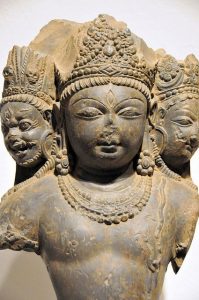
Another well known representation of 3-headed Shiva is seen at Elephanta or Gharapuri Caves. This 20 ft high colossus was carved out of a single rock in 6-7th century (shown below, in center). This amazing masterpiece provides all the details of three forms of Shiva, which essentially remained unchanged over 2 millenniums. Three Kushan rulers, Huvishka, Vasudeva I and Kanishka II minted three-headed Shiva coins, all are shown here (above and below).
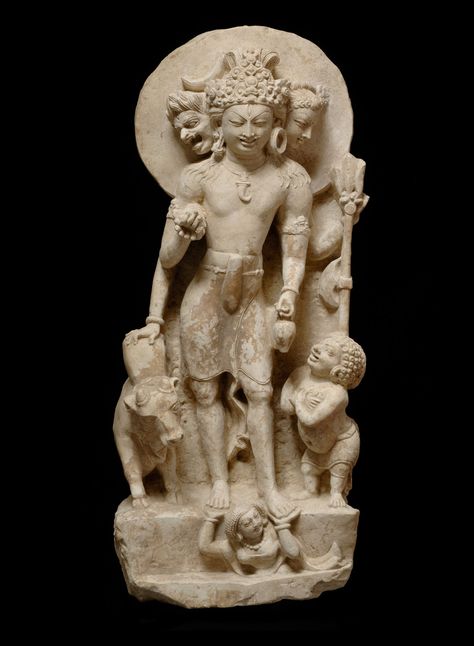
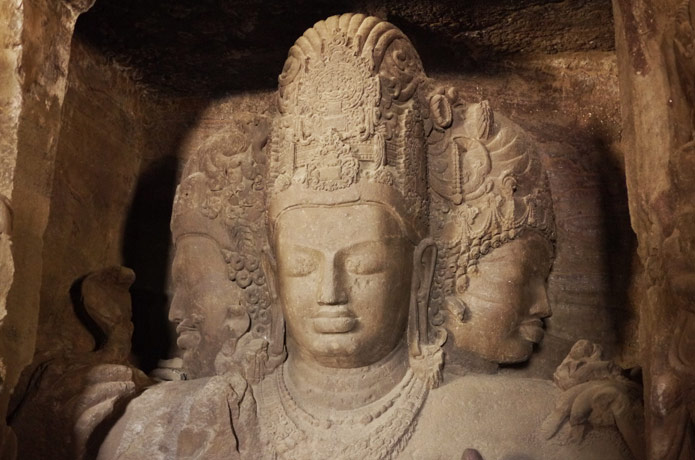



Vasudeva I
Kushan Dynasty 192-228 AD, Staer/Dinar Weight: 8.0 gm Gold
Obverse: King Sacrificing at Altar
Reverse: Three-headed Shiva, side heads are NOT human, boar and Lion type Shiva standing with his Nandi, holding trident.
Very Rare
Reference: Gobl#512.3, About Extremely Fine
Interestingly, there are some extremely rare Kushan coins by Vasudeva that show the side heads to be boar and Lion (see above). This could be attempt to show two major deities of Hinduism, Lord Vishnu and Shiva in a single form, Harihara.
Not surprisingly, one do find this representation in contemporary sculptures. On right is the incredible sculpture of Lord Vishnu carved out of white marble during rule of Hindu Shahi (Shahiya) Dynasties, 4-7th century CE. These successors of Kushan, ruled modern Pakistan & Afghanistan. He is holding holding a chakra in one hand, conch-shell in the other, his head flanked by two of his avatars, lion (Narashimha) and boar (Varaha).
On far right is the complex form of Vishnu, first referred to by the name Vaikuntha in the seventh-century VishnuDharmottara Purana, is four-faced (chaturmurti), with the heads of a lion (right) and a boar (left) flanking a human head. He is also identifiable in this form by the epithet Para-Vasudeva, “the highest god”. Carved on the back of the halo is the fourth face, a demonic, grimacing representation with fangs and a vertical third eye on the forehead.

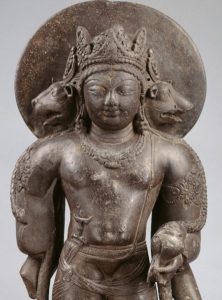
KANISHKA II (228-250 AD)
Kushan empire had started its decline soon after Vasudeva’s death. Vasudeva was followed by Kanishka II, who lost all the territories west of river Indus to Sassanians. Sassanians princes ruled this region and called themselves Kushanshahs and minted coins which were influenced by both Kushan and sassanian style. Kingdom of Kanishaka II consisted of provinces east of river Indus, Taxila (modern Pakistan), Punjab and region around Mathura (northern India). His coinage can be divided into two types:
(1) Goddess Ardoksho (Laxmi) on reverse minted at Mathura
(2) Shiva and Nandi on reverse minted at Taxila
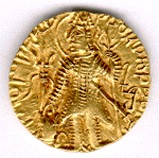
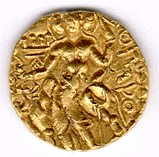
Kanishka II
Stater, Weight: 7.8 gm Gold
Obverse: King Sacrificing at Altar with his right hand, he is holding a trident in his left hand, in left field a Brahmi Akshara Ga is shown while in right field another Brahmi Akshara Pri is present. Legend in bactrian at the edge.
Reverse: Three-headed Shiva standing with his vehicle Nandi, Bactrian legend is at the edge, OHPO is on his left.
Reference: Gobl#635.7, ONS#156 (this specimen)
Extremely Fine
Exceedingly Rare (Only other known specimen is in Gobl).
Most of the coins minted by Kanishka II show image of seated goddess Ardoksho or Ardoxo (Laxmi as in later era) on reverse. A few Shiva depicting coins are minted by him (as cataloged by Prof. Robert Gobl #635) as reglar issue, except specimen #635.7, which shows three-headed Shiva which is the only coin of Kanishka II that depicts three-headed Shiva image (shown above). Unlike his predecessors, Kanishaka II and kings who followed him (Vasudeva II, Vashishka, Shaka and many more) minted coins bears Bramhi characters.
VASHISHKA (250-268 AD)
Vashishaka was one of the last major ruler of Kushan dynasty. His coin depicting Shiva is shown above. After Vashishka the Kushan empire had completely disintegrated into few smaller kingdoms. By fourth century AD this dynasty went into total obscurity with advent of mighty Gupta emperors.
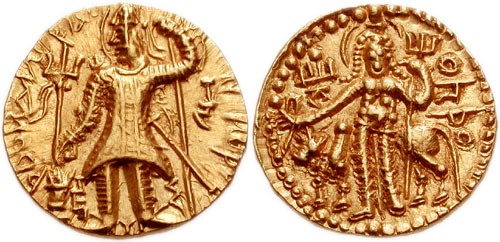
Vashishka
Kushan Dynasty 250-268 AD Stater, Weight: 7.85 gm , Gold
Obverse: Vasishka, nimbate and helmeted, standing facing, head left, sacrificing over altar to left and holding filleted standard; to left, filleted trident behind, “Jira” to right of altar, “Gho” between Vasishka’s feet, “Ku?” to left and “Rada” to right of sceptre in Brahmi
Reverse: Shiva standing facing, holding diadem and trident; behind, the bull Nandi standing left; to left, a dot (•) above tamgha.
Reference: MK 630; MACW 3505 corr. (“Ku?” present, but not mentioned). Nearly Extremely Fine, choice specimen
Rare
MAGRA (4th Century AD)

